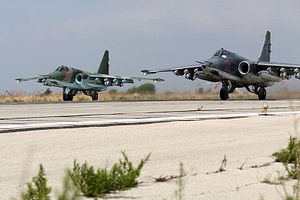Russia’s military has received more than 1,200 new and modernized aircraft over the past three years, the Russian Deputy Defense Minister Yuri Borisov said at a Russian aviation industry conference last week, according to TASS.
“Undoubtedly, the domestic aviation industry has achieved strong performance at present, and the involvement of the Russian Defense Ministry has played a significant role in this. Over the past three years, in 2013-2015, we have received from you 250 new planes, 300 helicopters, 700 aircraft that underwent serious modernization with repairs,” Borisov elaborated during his speech.
New and modernized aircraft include the Sukhoi Su-34 bombers, multipurpose Su-30SM and Su-35S fighter jets, MiG-29 SMT, MiG-35, Yakovlev Yak-130 advanced trainers/light fighters and Ilyushin Il-76MD-90 transport planes. New and upgraded helicopters encompass the Kamov Ka-52 and Mil Mi-28N attack helicopters, Mi-8AMTSh assault-transport helicopters, Mi-35 combat helicopters, and Ka-226 utility aircraft.
The Russian military is also in the process of upgrading its fleet of 15 Tupolev Tu-160M2 long-range supersonic strategic bombers by 2019. In addition, Russia plans to acquire 50 new Tu-160M2s, with three new bombers inducted into the armed forces per year starting in 2023.
The Su-30SM has become the mainstay of Russian combat jet airpower, with Russia recently placing an order for an additional 30 4++ generation fighter jets slated to enter service with the Aerospace Forces by the end of 2018. (The Russian Air Force was merged with the Russian Aerospace Defense Forces in August 2015.)
Russia’s recent financial troubles have only marginally impacted the so-called 2011-2020 State Armament Program and modernization and upgrades will continue, albeit at a slower pace in the years ahead. However, as I reported before, (See: “Is the ‘World’s Deadliest Tank’ Bankrupting Russia?”), the Russian government, in the long run, cannot afford military expenditures as seen in 2014 and 2015:
The only way for Russia to currently finance its growing military expenditure is to tap into the country’s reserve fund – money the Kremlin put aside over the last few years when oil prices were high and meant to cushion the economy against shocks. With the help of the reserve fund – worth approximately six percent of the country’s total GDP – Russia could maintain a 3.7 percent [budget] deficit for less than two years(…).
In September 2015, U.S. Air Force General Frank Gorenc, the commander of U.S. Air Forces in Europe and Africa, said that NATO’s air superiority in relation to the Russian military is fading. “The advantage that we had from the air, I can honestly say, is shrinking not only with respect to the aircraft that they’re producing, but the more alarming thing is their ability to create anti-access/area-denial [A2/AD] that are very well defended,” Gorenc said.

































